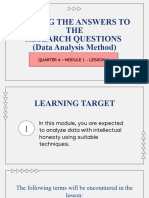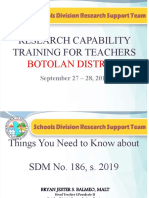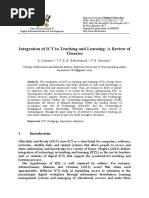PR1 - Lesson 7 - Data Analysis Procedure
Uploaded by
Charlotte Aspecto LladonesPR1 - Lesson 7 - Data Analysis Procedure
Uploaded by
Charlotte Aspecto LladonesPRACTICAL RESEARCH 1
LESSON 7: Data Analysis Procedure
A. INTERVIEW. Interview is defined as a purposeful face to face relationship between two persons, one of whom called the
interviewer who asks questions to gather information and the other called the interviewee or respondent who supplies the
information asked for.
➢ TYPES OF INTERVIEWS
o Structured Interviews. Use a set of questions prepared by the researcher. During the course of the interview, the
researcher or interviewer codes the responses.
o Unstructured Interviews. Use open-ended questions which the interviewee or research participant answers freely.
o Semi-structured Interviews. Use both closed and open-ended questions.
B. PARTICIPANT OBSERVATION. The researcher immerses himself/herself in the natural setting of the research participant, this
can be a home, an office, an institution, etc.
C. FOCUS GROUP INTERVIEW. 6 to 8 persons participate in the interview. The advantage of this is that critical issues or sensitive
ones can be more freely discusses with a group.
D. OBSERVATIONAL EVALUATION. The researcher may or may not participate in activities of the group being observed. But
mostly, both the verbal and non-verbal behavior of a person or group of persons.
Data Analysis Procedures
➢ It involves the identification, examination, and interpretation of patterns and themes in textual data and determines how
these patterns and themes help answer the research questions.
The Process of Qualitative Data Analysis
1. Getting to know the data. This is done by reading and re-reading the text. The taped recordings should be played and listened
to several times: thus, a transcription of the interview is an important tool to prepare.
2. Focusing the analysis.
a. Focus by question or topic, time period, or event. This is usually done in open-ended questions. This can be done by
looking how all individuals or groups responded to each question or topic, or for a give time period or event; organizing the
data by question to look across all
respondents and their answers to
identify consistencies ad
differences; consolidating all data
from questions; applying the same
approach to particular topics, time
periods, or events of interest; and
exploring the connections and
relationships between questions.
b. Focus by case, individual, or
group. A case can be a single
family; an individual can be a first-
timer or teen participants; and a
group can be categorized by ages.
3. Annotating. This is the process used for
analyzing an article or a text. It is done
by writing symbols and notes on the
transcript, especially on its margins,
while reading and re-reading the
transcribed text.
a. Asterisk or star (*) – this is used to
remember the most important text.
b. Encircle – this is done to remember
words that are peculiar.
c. Underline – this is done to
remember phrases and sentences.
d. Question Mark – this is used on a
controversial remark that needs to
be clarified.
e. Arrow – this is used to connect
related words, sentences, or even
paragraphs.
f. Parallel Lines beside the
paragraph – these are used to
remember the important
paragraphs.
Prepared by: Ms. Ma. Veronica Anne E. Bengala, LPT
g. Numbers - these are used to remember sequences of
answers or events.
h. Color Coding – color-coded marking made using colored
pens can be used in place of symbols.
4. Coding
➢ Coding can be defined as the actual process of making sure
data is organized into chunks or segments and later making
meaning out of it.
➢ It involves assigning a word, phrase, number or symbol to
each coding category.
➢ Predefined codes refer to codes that are formulated by the
researcher based on his or her knowledge of the reviewed
literatures.
➢ Emergent codes refer to codes that become apparent as one reviews the data.
5. Entering and organizing the data. This can be done manually by using a piece of paper or through computers.
Prepared by: Ms. Ma. Veronica Anne E. Bengala, LPT
6. Cleaning the Data. This is the process of checking data for errors. The “dirty” data, when not eliminated, can negatively influence
the results of the study.
a. Spot-checking. This technique involves comparing the raw data to electronically entered data to check for data and
coding errors. For qualitative data, one should use this approach to check whether the participants’ words were
transcribed accurately and attributed to the right individual.
b. Eye-balling. This technique involves reviewing the data for errors that may have resulted from a data entry or coding
oversight.
c. Logic check. This technique involves a careful review of the electronically entered data to make sure that the answers
to the different questions “make sense”.
7. Identifying meaningful patterns and themes. This is the core process of qualitative data analysis.
a. Content analysis. This is carried out by coding the data for certain words or content by going through all the text and
label words, phrases, and sections of the text; or devising a matrix to group for categories of the texts when listening
to a recorded interview; identifying their patterns; and interpreting their meanings.
Prepared by: Ms. Ma. Veronica Anne E. Bengala, LPT
b. Thematic Analysis. This is the process of analyzing
the data by grouping them according to themes.
Themes either evolve directly from the research
questions or preset, or naturally emerge from the
resulting data. The initial list of categories may change
as one works with the data.
8. Interpreting the data. After identifying and analyzing, coding and organizing a presentation, and identifying the themes and
patterns, the next step is to interpret the results.
➢ Levels of Interpretation
o Level 1. Data collected are compared and contrasted and any unexpected results may be included. Comments on
certain shortcomings of the study may be made but they should not overly emphasize the flaws.
o Level 2. The internal validity of the results, as well as their consistency or reliability, is explained. The causes or
factors that may have influenced the results are described.
o Level 3. The external validity of the results, that is, their generality or applicability of external condition is explained.
o Level 4. The data are related to theoretical research or with reviewed literature.
Prepared by: Ms. Ma. Veronica Anne E. Bengala, LPT
You might also like
- Structures and Elements of Filipino ValuesNo ratings yetStructures and Elements of Filipino Values11 pages
- Finding The Answers To The Research Questions Qualitative Quantitative Data Analysis Method100% (2)Finding The Answers To The Research Questions Qualitative Quantitative Data Analysis Method2 pages
- Senior High School Department: Practical Research 1No ratings yetSenior High School Department: Practical Research 17 pages
- Finding The Answers To The Research Questions Lesson 1-Data Analysis MethodNo ratings yetFinding The Answers To The Research Questions Lesson 1-Data Analysis Method4 pages
- Educational Research: The Case Study MethodologyNo ratings yetEducational Research: The Case Study Methodology52 pages
- Educational Research: The Case Study MethodologyNo ratings yetEducational Research: The Case Study Methodology52 pages
- Designing Reseorch Qualitative Procedures: Questi0118 FroidNo ratings yetDesigning Reseorch Qualitative Procedures: Questi0118 Froid12 pages
- (Emerson) Data analysis and interpretationNo ratings yet(Emerson) Data analysis and interpretation7 pages
- Qualitative Data Presentation, Analysis and InterpretationNo ratings yetQualitative Data Presentation, Analysis and Interpretation18 pages
- 1.analyzing The Meaning of The Data and Drawing ConclusionNo ratings yet1.analyzing The Meaning of The Data and Drawing Conclusion27 pages
- Inquiries, Investigation, and Immersion: Quarter 2 Module 1-Lesson 1100% (2)Inquiries, Investigation, and Immersion: Quarter 2 Module 1-Lesson 114 pages
- Detailed Lesson in Practical Research 1 Data Analysisa4 PDF FreeNo ratings yetDetailed Lesson in Practical Research 1 Data Analysisa4 PDF Free7 pages
- III-Topic 5 Finding The Answers To The Research Questions (Data Analysis Method)100% (2)III-Topic 5 Finding The Answers To The Research Questions (Data Analysis Method)34 pages
- Educational Research: Qualitative Research Methods100% (2)Educational Research: Qualitative Research Methods119 pages
- Name: - Grade and Section: - Date SubmittedNo ratings yetName: - Grade and Section: - Date Submitted3 pages
- Gathers Information From Survey Experiments or ObservationNo ratings yetGathers Information From Survey Experiments or Observation20 pages
- Finding The Answers To The Research Questions Lesson 1-Data Analysis MethodNo ratings yetFinding The Answers To The Research Questions Lesson 1-Data Analysis Method5 pages
- Gathering and Analyzing Data With Intellectual Honesty Using Suitable Techniques Qualities of Good QuestionaireNo ratings yetGathering and Analyzing Data With Intellectual Honesty Using Suitable Techniques Qualities of Good Questionaire4 pages
- PR1 - Lesson 8 - Formulating Conclusion and Recommendation100% (1)PR1 - Lesson 8 - Formulating Conclusion and Recommendation2 pages
- PR1 - Lesson 6 - Sample and Sampling TechniquesNo ratings yetPR1 - Lesson 6 - Sample and Sampling Techniques2 pages
- How To Maintain Interpersonal RelationshipsNo ratings yetHow To Maintain Interpersonal Relationships5 pages
- Student's Error Analysis in Finishing Mathematic Word Problem Based Newman AnalysisNo ratings yetStudent's Error Analysis in Finishing Mathematic Word Problem Based Newman Analysis11 pages
- Week 5 - Ethico - Legal and Moral Considerations in Nursing Leadership ManagementNo ratings yetWeek 5 - Ethico - Legal and Moral Considerations in Nursing Leadership Management29 pages
- Local and Global Communication in Multicultural SettingNo ratings yetLocal and Global Communication in Multicultural Setting4 pages
- Really Distinguishing Essence From EsseNo ratings yetReally Distinguishing Essence From Esse55 pages
- Module 1 (Lesson 1 - Kants Postulates On Ethical Morality)No ratings yetModule 1 (Lesson 1 - Kants Postulates On Ethical Morality)6 pages
- BI Y6 LP TS25 (Unit 3 - Adventure Time - LP 33-48)No ratings yetBI Y6 LP TS25 (Unit 3 - Adventure Time - LP 33-48)17 pages
- Philosophy of Education: Prepared By: Mr. John Rold Gley A. Panaligan Mr. Kitz Byron C. CastilloNo ratings yetPhilosophy of Education: Prepared By: Mr. John Rold Gley A. Panaligan Mr. Kitz Byron C. Castillo48 pages
- Integration of ICT in Teaching and Learning: A Review of TheoriesNo ratings yetIntegration of ICT in Teaching and Learning: A Review of Theories16 pages
- New Materialist Approaches To The Study of Language and Identity Assembling The Posthuman SubjectNo ratings yetNew Materialist Approaches To The Study of Language and Identity Assembling The Posthuman Subject18 pages
- Technology As A Way of Revealing: Study Guide For Module No. 5No ratings yetTechnology As A Way of Revealing: Study Guide For Module No. 54 pages
- Finding The Answers To The Research Questions Qualitative Quantitative Data Analysis MethodFinding The Answers To The Research Questions Qualitative Quantitative Data Analysis Method
- Senior High School Department: Practical Research 1Senior High School Department: Practical Research 1
- Finding The Answers To The Research Questions Lesson 1-Data Analysis MethodFinding The Answers To The Research Questions Lesson 1-Data Analysis Method
- Designing Reseorch Qualitative Procedures: Questi0118 FroidDesigning Reseorch Qualitative Procedures: Questi0118 Froid
- Qualitative Data Presentation, Analysis and InterpretationQualitative Data Presentation, Analysis and Interpretation
- 1.analyzing The Meaning of The Data and Drawing Conclusion1.analyzing The Meaning of The Data and Drawing Conclusion
- Inquiries, Investigation, and Immersion: Quarter 2 Module 1-Lesson 1Inquiries, Investigation, and Immersion: Quarter 2 Module 1-Lesson 1
- Detailed Lesson in Practical Research 1 Data Analysisa4 PDF FreeDetailed Lesson in Practical Research 1 Data Analysisa4 PDF Free
- III-Topic 5 Finding The Answers To The Research Questions (Data Analysis Method)III-Topic 5 Finding The Answers To The Research Questions (Data Analysis Method)
- Educational Research: Qualitative Research MethodsEducational Research: Qualitative Research Methods
- Gathers Information From Survey Experiments or ObservationGathers Information From Survey Experiments or Observation
- Finding The Answers To The Research Questions Lesson 1-Data Analysis MethodFinding The Answers To The Research Questions Lesson 1-Data Analysis Method
- Gathering and Analyzing Data With Intellectual Honesty Using Suitable Techniques Qualities of Good QuestionaireGathering and Analyzing Data With Intellectual Honesty Using Suitable Techniques Qualities of Good Questionaire
- How to Research Qualitatively: Tips for Scientific WorkingFrom EverandHow to Research Qualitatively: Tips for Scientific Working
- PR1 - Lesson 8 - Formulating Conclusion and RecommendationPR1 - Lesson 8 - Formulating Conclusion and Recommendation
- Student's Error Analysis in Finishing Mathematic Word Problem Based Newman AnalysisStudent's Error Analysis in Finishing Mathematic Word Problem Based Newman Analysis
- Week 5 - Ethico - Legal and Moral Considerations in Nursing Leadership ManagementWeek 5 - Ethico - Legal and Moral Considerations in Nursing Leadership Management
- Local and Global Communication in Multicultural SettingLocal and Global Communication in Multicultural Setting
- Module 1 (Lesson 1 - Kants Postulates On Ethical Morality)Module 1 (Lesson 1 - Kants Postulates On Ethical Morality)
- BI Y6 LP TS25 (Unit 3 - Adventure Time - LP 33-48)BI Y6 LP TS25 (Unit 3 - Adventure Time - LP 33-48)
- Philosophy of Education: Prepared By: Mr. John Rold Gley A. Panaligan Mr. Kitz Byron C. CastilloPhilosophy of Education: Prepared By: Mr. John Rold Gley A. Panaligan Mr. Kitz Byron C. Castillo
- Integration of ICT in Teaching and Learning: A Review of TheoriesIntegration of ICT in Teaching and Learning: A Review of Theories
- New Materialist Approaches To The Study of Language and Identity Assembling The Posthuman SubjectNew Materialist Approaches To The Study of Language and Identity Assembling The Posthuman Subject
- Technology As A Way of Revealing: Study Guide For Module No. 5Technology As A Way of Revealing: Study Guide For Module No. 5





























































































